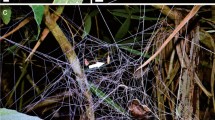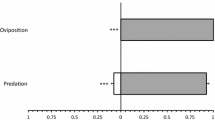Abstract
Field studies near Zurich (Switzerland) have shown, that adult Lepidoptera often are able to escape from spider webs of the families Argiopidae and Tetragnathidae. In the food of these orb-weaving spiders Lepidoptera made up only a very small part. The capability of the lepidopterans to escape from spider webs seems to be of great ecological importance.
Zusammenfassung
Beobachtungen bei Zürich ergaben, daß Lepidopteren-Falter oft in der Lage sind, sich aus Spinnennetzen von Arten der Argiopidae und Tetragnathidae zu befreien. Lepidopteren machen nur einen sehr kleinen Teil der Nahrung dieser Spinnen aus. Diese Tatsache muß bei der Bewertung von Spinnen als Schädlingsfeinde mit berücksichtigt werden.
Similar content being viewed by others
Literaturverzeichnis
Alcock, J., 1977: Animal Behavior: An Evolutionary Approach. Sinauer Associates, Inc., Massachusetts, 547 pp.
Dabrowska-Prot, E., andJ. Luczak, 1968: Studies on the incidence of mosquitoes in the food ofTetragnatha montana Simon and its food activity in the natural habitat. Ekol. Pol. A16, 843–853.
Eisner, T., R. Alsop andP. Ettershank, 1964: Adhesïveness of spider silk. Science146, 1058–1061.
Kajak, A., 1965: An analysis of food relations between the spider —Araneus cornutus Cl. andAraneus quadratus Cl. — and their prey in meadows. Ekol. Pol. A13, 717–764.
Lohmeyer, W., undP. Pretscher, 1979: Über das Zustandekommen halbruderaler Wildstauden-Quecken-Fluren auf Brachland in Bonn und ihre Bedeutung als Lebensraum für die Wespenspinne. Natur und Landschaft54, 253–259.
Nyffeler, M., undG. Benz, 1981 a: Ökologische Bedeutung der Spinnen als Insektenprädatoren in Wiesen und Getreidefeldern. Mitt. dtsch. Ges. allg. angew. Ent. (im Druck).
Nyffeler, M., undG. Benz, 1981 b: Freilanduntersuchungen zur Nahrungsökologie der Spinnen: Beobachtungen aus der Region Zürich. Anz. Schädlingskde., Pflanzenschutz, Umweltschutz54, 33–39.
Nyffeler, M., undG. Benz, 1981 c: Eine Notiz zum Beutefangverhalten der RadnetzspinneArgiope bruennichi (Scopoli) (in Vorber.).
Robinson, M. H., andB. Robinson, 1970: Prey caught by a sample population of the spiderArgiope argentata (Araneae: Araneidae) in Panama: a year's census data. Zool. J. Linn. Soc.49, 345–358.
Thornhill, R., 1975: Scorpionflies as kleptoparasites of web-building spiders. Nature258, 709–711.
Author information
Authors and Affiliations
Additional information
Mit einer Tabelle
Ausgeführt mit Unterstützung durch den schweizerischen Nationalfonds zur Förderung der Wissenschaftlichen Forschung.
Rights and permissions
About this article
Cite this article
Nyffeler, M., Benz, G. Einige Beobachtungen über die Flucht von adulten Lepidopteren aus den Netzen orbiteler Spinnen. Anz. Schadlingskde., Pflanzenschutz, Umweltschutz 54, 113–114 (1981). https://doi.org/10.1007/BF01905996
Issue Date:
DOI: https://doi.org/10.1007/BF01905996




